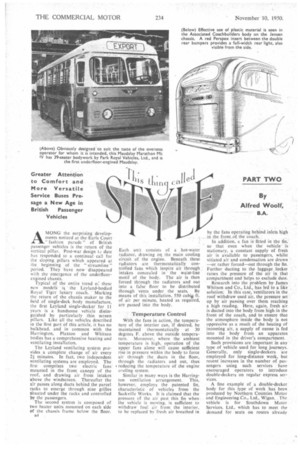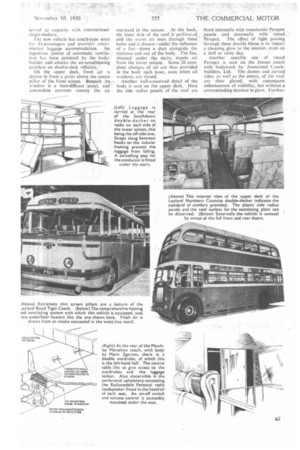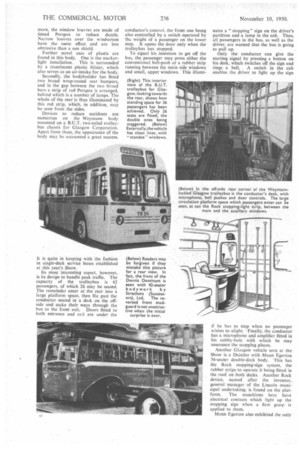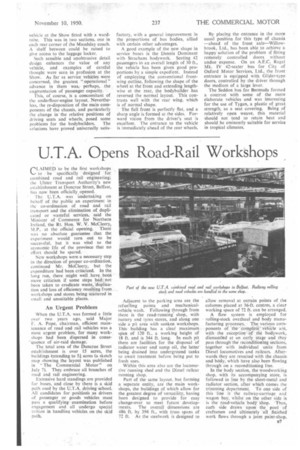By Alfred Woolf, B.A.
Page 38

Page 39

Page 40

Page 41

If you've noticed an error in this article please click here to report it so we can fix it.
AV1ONG the surprising developments noticed at the Earls Court fashion parade" of British passenger vehicles is the return of the vertical pillar. Post-war design ta date has responded to a continual call for the sloping, pillars which appeared at the beginnine of the " streamline " period. They have now disappeared with the emergence of the underfloorengined chassis.
Typical of the entire trend o: these new models is the Leyland-bodied Royal Tiger luxury coach. Marking the return of the chassis maker to the field of single-deck body manufacture, the first Leyland single-decker for 11 years is a handsome vehicle distinguished by particularly thin screen pillars. Like all the vehicles described in the first part of this article, it has no bulkhead, and in common with the 1-farrington, Plaxton and Whitson bodies has a comprehensive heating and ventilating installation.
The Leyland ventilating system provides a complete change of air every 211 minutes. In fact, two independent ventilating systems are employed. The first comprises two electric fans mounted in the front canopy of the roof, and drawing air from intakes above the windscreen. Thereafter the air passes along ducts behind the parcel racks to emerge through nine grilles situated under the racks and controlled by the passengers.
The second system is composed of two heater units mounted on each side of the chassis frame below the floor. Each unit consists of a hot-water radiator, drawing oil the main cooling circuit of the engine. Beneath these radiators are thermostatically controlled fans which inspire air through intakes concealed in the waist-line motif of the body. The air is then forced through the radiators and out into a false floor to be distributed through vents under the seats. By means of this installation, 550 cubio ft, of air per minute, heated as required, are passed into the body.
Temperature Control
'With the fans in action, the temperature of the interior can, if desired, be maintained thermostatically at 30 degrees F. above the outside temperature. Moreover, where the ambient temperature is high, operation of the upper fans alone will cause sufficient rise in pressure within the body to force air through the ducts in the floor, through the radiators and out. thus reducing the temperature of the engine cooling system.
Similar in many ways is the Harrington ventilation arrangement. This, however, employs the patented fin, characteristic of vehicles from the Sackville Works. It is claimed that the pressure of the air past this fin when the vehicle is moving, is sufficient to withdraw foul air from the interior. to be replaced by fresh air breathed in by the fans operating behind inlets high in the front.of, the coach.
In addition, a fan is fitted in the fin; so that even when the vehicle is stationary, a constant supply of fresh air is available to passengers, whilst vitiated air and condensation are drawn —or rather forced—out through the fin. Further ducting to the luggage locker raises the pressure of the air in that compartment and helps to exclude dust.
Research into the problem by James Whitson and Co., Ltd., has led to a like solution: In this case, ventilators in the roof withdraw used air, the pressure set up by air passing over them reaching a high reading. Here, again, fresh air is ducted into the body from high in the front of the coach, and to ensure that the atmosphere inside the body is not oppressive as a result of the heating of incoming air, a supply of ozone is fed into the body from an apparatus mounted in the driver's compartment.
Such provisions are important in any type of vehicle used for long journeys. Generally, only single-deckers are employed for long-distance work, but recent increases in the number of passengers using such services have encouraged operators to introduce double-deckers on regular express services.
A fine example of a double-decker body for this type of work has been produced by Northern Counties Motor and Engineering Co., Ltd.. Wigan. The vehicle is for Southdown Motor Services. Ltd.. which has to meet the demand for seats on routes already served to capacity with conventional single-deckers.
The new vehicle has coach-type seats for 44-passengers and provides ample interior luggage accommodation. An ingenious system of automatic ventilation has been patented by the bodybuilder and attacks the air-conditioning problem on double-deck vehicles.
On the upper deck, fresh air is drawn in from a point above the centre pillar of the front screen. Beneath he window is a heat-diffuser panel, and convection currents convey the air rearward in the saloon. At the back, the inner skin of the roof is perforated and the warm air rises through these' holes and is drawn—under the influence of a fan—down a duct alongside the staircase and out of the body. The fan, situated under the. stairs, expels air from the lower saloon. Some 20 complete changes of air are thus provided in the body each hour, even when all w:ndows are closed.
Another well-conceived detail of the body is seen on the upper deck. Here the side radius panels of the roof are fitted internally with translucent Perspex panels and externally with tinted Perspex. The effect of light passing through these double filters is to impart a cheering glow to the interior, even on a dull or rainy day.
Another sensible use of tinted Perspex is seen on the Jensen coach with bodywork by Associated Coachbuilders, Ltd. The domes and curved sides. as well as the centre, of the roof are thus glazed, with consequent enhancement of visibility, but without a corresponding increase in glare. Further more, the window louvres are made of tinted Perspex to reduce dazzle. Narrow louvres over the windscreen have the same effect and are less obtrusive than a sun shield.
Further novel uses of plastic are found in this body. One is the markerlight installation. This is surrounded by a translucent plastic blister, which also serves as an air-intake for the body.
Secondly, the bodybuilder has fitted two broad wrap-round rear bumpers, and in the gap between the two broad bars a strip of red Perspex is arranged, behind which is a number of lamps. The whole of the rear is thus illuminated by this red strip, which, in addition, may be seen from the sides.
Devices to reduce accidents are numerous on the Weymann body mounted on a B.U.T. two-axled trolleybus chassis for Glasgow Corporation. Apart from these, the appearance of the body may be accounted a great success.
Is is quite in keeping with the fashion in single-deck service buses established at this year's Show.
Its most interesting aspect, however. is its design to handle peak traffic. The capacity of the trolleybus is 62 passengers, of which 26 may be seated. The remainder enter at the rear into a large platform space, then file past the conductor seated in a desk on the offside and make their ways through the bus to the front exit. Doors fitted to both entrance and exit are under the conductor's control, the front one being also controlled by a switch operated by 'the weight of a passenger on the lower step. It opens the door only when the trolleybus has stopped.
To signal his intention to get off the bus, the passenger may press either the conventional bell-push or a rubber strip running between the main side windows and small, upper windows. This illumi
nates a "stopping" sign on the driver's partition and a lamp in the cab. Thus. all passengers in the bus, as well as the driver, are warned that the bus is going to pull up.
Only the conductor can give the starting signal by pressing a button on his desk, which switches off the sign and
rings a bell. A switch in the cab enables the driver to light up the sign if he has to stop when no passenger wishes to alight. -Finally, the conductor has a microphone and amplifier fitted in his cubby-hole with which he may announce the stopping places.
Another Glasgow vehicle seen at the Show is a Daimler with Mann Egerton 56-seater double-deck body. This has the Rock stopping-sign system, the rubber strips to operate it being fitted in the roof on both decks. Another Rock device, named after the inventor, general manager of the Lincoln municipal undertaking, is found on the platform. The stanchions here have electrical contacts which light up the stopping sign when a firm grasp is applied to them.
Mann Egerton also exhibited the only
vehicle at the Show fitted with a wardrobe. This was in two sections. one in each rear corner of the Maudslay coach. A shelf between could be raised to give access to the luggage locker.
Such sensible and unobtrusive detail design enhances the value of any vehicle, and examples of careful thought were seen in profusion at the Show. As far as service vehicles were concerned, the greatest "operational" advance in them was, perhaps, the augmentation of passenger capacity.
This, of course, is a concomitant of the underfloor-engine layout. Nevertheless, the re-disposition of the main components of the chassis, and particularly the change in the relative positions of driving seats and wheels, posed some
problems for the bodybuilders. The st:dutions have proved universally satis factory, with a general improvement in the proportions of bus bodies, allied with certain other advantages.
A good example of the new shape in service buses is the Dennis Dominant with Strachans bodywork. Seating 42 passengers in an overall length of 30 ft., the vehicle has been given good proportions by a simple expedient. Instead of employing the conventional frontwing outline, following the shape of the wheel at the front and extending lengthwise at the rear, the bodybuilder has reversed the normal layout. This contrasts well with the rear wing, which is of normal shape.
The full front is perfectly flat, and a sharp angle is formed at the sides. Forward vision from the driver's seat is excellent. The entrance to the vehicle is immediately ahead of the rear wheels.
By placing the entrance in the more usual position for this type of chassis —ahead of the front axle—Willowbrook, Ltd., has been able to achieve a happy solution of the problem fitting remotely controlled doors without undue expense. On an A.E.C. Regal Mk. IV 42-seater bus for City of Oxford Motor Services, Ltd.. the front entrance is equipped with Glider-type doors, controlled by the driver through the medium of a large lever.
The Seddon bus for Bermuda formed a contrast with some of the more elaborate vehicles and was interesting for the use of Tygan, a plastic of great strength, as a seat covering. Being of relatively open weave, this material should not tend to retain heat and should be eminently suitable for service in tropical climates.




















































































